Rock climbing is an exhilarating and challenging sport that combines physical strength, mental focus, and a deep connection with the natural world. Whether you’re a beginner taking your first steps on an indoor wall or venturing into the great outdoors, it’s important to approach climbing with the right knowledge, techniques, and mindset.
This guide provides a comprehensive set of Beginner Climbing Tips, covering various aspects of the sport, including climbing techniques, safety practices, mental preparation, training strategies, and outdoor climbing considerations. By following these tips, you can lay a solid foundation for your climbing journey and progress with confidence.
Rock climbing is not just a sport—it’s a journey of personal growth, resilience, and self-discovery. With the right knowledge, preparation, and mindset, you can embark on a fulfilling climbing adventure while staying safe and pushing your limits. So, whether you’re a beginner seeking new heights or an experienced climber looking to reinforce your foundation, these rock climbing tips are designed to support you on your path to becoming a confident and skilled climber.
Table of Contents
What Are The Best Beginner Climbing Tips?
1. Before You Climb
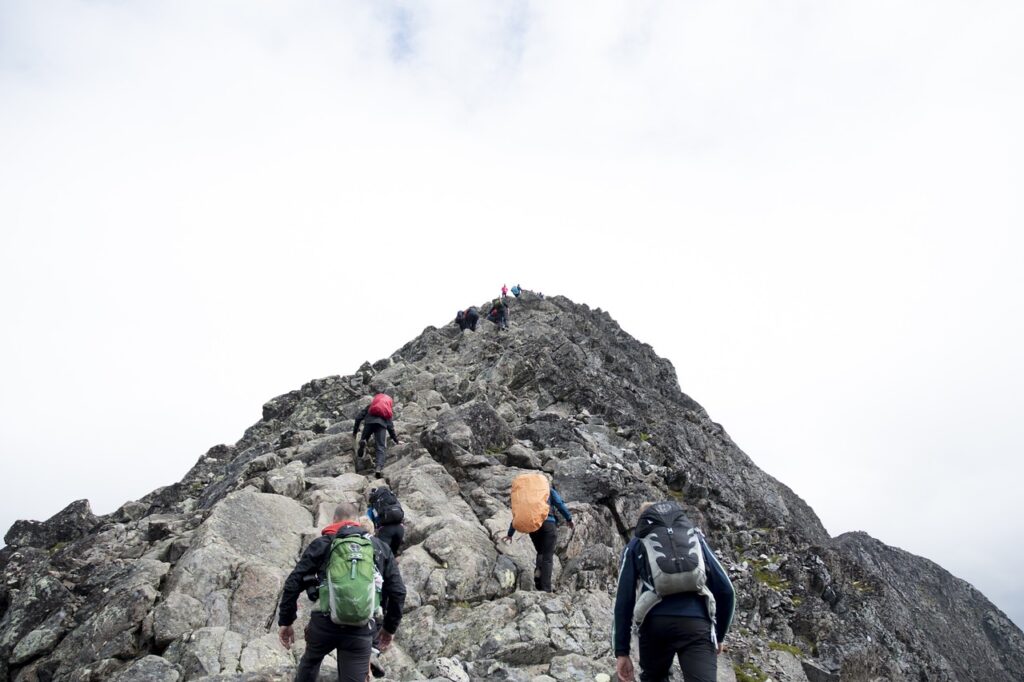 Before embarking on your rock climbing adventure, it’s essential to take certain preparatory steps to ensure a safe and enjoyable experience. This section, “Before You Climb,” provides valuable tips and guidance for beginner climbers to make the most out of their climbing journey.
Before embarking on your rock climbing adventure, it’s essential to take certain preparatory steps to ensure a safe and enjoyable experience. This section, “Before You Climb,” provides valuable tips and guidance for beginner climbers to make the most out of their climbing journey.
From selecting the right climbing gear to understanding the importance of warming up and checking weather conditions, these tips will help you lay a solid foundation for a successful climb. By taking the time to prepare and equip yourself with the necessary knowledge, you can approach your climbing sessions with confidence and peace of mind.
-
Invest in Good Quality Climbing Gear
- Climbing Shoes: Choose shoes that fit snugly and provide excellent traction on the rock surface.
- Harness: Opt for a harness that is comfortable and properly fits your body.
- Helmet: Protect your head from falling rocks or potential impacts by wearing a well-fitting helmet.
- Ropes: Use dynamic ropes that are designed to absorb the force of a fall.
-
Get an Instructor or Mentor
- Learning Proper Techniques: An instructor can teach you essential climbing techniques such as belaying, knot tying, and efficient movement on the wall.
- Safety Awareness: Mentors help instill a strong sense of safety awareness and risk management, ensuring you understand potential hazards and how to mitigate them.
- Building Confidence: A knowledgeable guide can help boost your confidence by gradually introducing you to more challenging climbs and providing encouragement along the way.
-
Find a Climbing Partner
- Safety: Having a climbing partner means you can rely on each other for safety checks, belaying, and catching falls.
- Motivation and Support: Climbing can be physically and mentally demanding, and having a partner to encourage and support you can make a significant difference in your progress.
- Sharing Experiences: Climbing with a partner allows you to share the joy and challenges of the sport, creating lasting memories together.
-
Get in Shape
-
- Upper Body: Focus on exercises such as pull-ups, push-ups, and shoulder presses to build upper body strength.
- Core Strength: Planks, Russian twists, and leg raises are effective exercises to strengthen your core.
- Leg Strength: Squats, lunges, and calf raises help to develop the leg strength necessary for climbing.
-
Stay Hydrated
- Carry Sufficient Water: Bring an adequate amount of water with you, considering the duration and intensity of your climbing session.
- Drink Regularly: Take small sips of water at regular intervals, even if you don’t feel thirsty. It’s essential to maintain hydration levels throughout your climb.
- Electrolyte Balance: Replenish electrolytes by consuming sports drinks or electrolyte-rich snacks to maintain proper hydration and prevent muscle cramps.
-
Fuel Up
- Balanced Nutrition: Consume a balanced meal that includes carbohydrates for energy, protein for muscle repair, and healthy fats for sustained fuel.
- Timing: Eat a meal or snack 1-2 hours before your climbing session to allow for digestion.
- Snack Options: Choose easily digestible snacks such as fruits, nuts, energy bars, or yogurt.
-
Warm-up
- Light Cardio: Start with a light cardiovascular exercise like jogging or jumping jacks to increase your heart rate and warm up your muscles.
- Stretching: Perform dynamic stretches that target your major muscle groups, including your arms, shoulders, legs, and hips. Focus on stretches that mimic climbing movements.
- Mobility Exercises: Incorporate exercises that enhance your joint mobility, such as wrist circles, shoulder rotations, and hip openers.
Related: Best Climbing Warm-Ups For Climbing – Crush Your Climb
2. Climbing Techniques
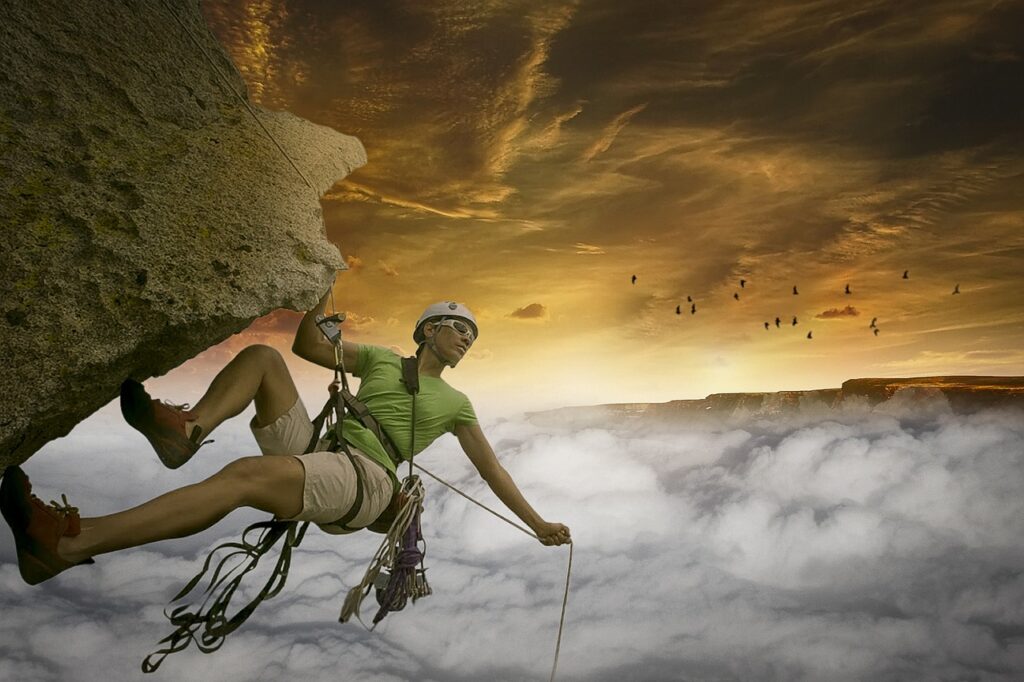 Mastering the art of climbing techniques is essential for beginners embarking on their rock climbing journey. In this section, we will explore a range of fundamental techniques that will help you navigate the wall with efficiency, conserve energy, and maintain balance. From learning essential knots to understanding proper body positioning and footwork, these tips will set you on the path to becoming a skilled and confident climber. Whether you’re tackling indoor walls or venturing into the great outdoors, these climbing techniques will provide you with a solid foundation to build upon. So, let’s dive in and discover the key techniques that will elevate your climbing skills to new heights!
Mastering the art of climbing techniques is essential for beginners embarking on their rock climbing journey. In this section, we will explore a range of fundamental techniques that will help you navigate the wall with efficiency, conserve energy, and maintain balance. From learning essential knots to understanding proper body positioning and footwork, these tips will set you on the path to becoming a skilled and confident climber. Whether you’re tackling indoor walls or venturing into the great outdoors, these climbing techniques will provide you with a solid foundation to build upon. So, let’s dive in and discover the key techniques that will elevate your climbing skills to new heights!
- Learn the basic climbing knots: Familiarize yourself with essential knots used in rock climbing, such as the figure-eight knot and the bowline knot. These knots are fundamental for tying yourself to the climbing rope and creating secure anchor points.
- Practice proper footwork and body positioning: Efficient footwork is crucial in rock climbing. Focus on placing your feet precisely on footholds and utilizing the strength in your legs to propel yourself upward. Additionally, pay attention to your body positioning, keeping it balanced and aligned with the wall to conserve energy and maintain stability.
- Use your legs more than your arms: As a beginner, it’s common to rely heavily on arm strength. However, using your legs to push yourself up instead of pulling with your arms is more efficient and will help you conserve energy throughout your climbs. Engage your leg muscles and use them as the primary force for upward movement.
- Learn how to read the route and plan ahead: Develop the ability to analyze the climbing route before you start. Identify key handholds, footholds, and potential challenges. Planning your moves in advance allows you to execute them more confidently and efficiently, saving energy and reducing the risk of mistakes.
- Grip holds with your fingertips: When gripping holds, use your fingertips rather than relying on your palms. Fingertip control provides better precision and allows for more delicate adjustments. This technique enhances your grip strength and helps you maintain control on challenging holds.
- Keep your center of mass low on climbing holds: Particularly when dealing with slopers—holds without well-defined edges—keep your center of mass low. Leaning into the wall and keeping your weight distributed over your feet will improve friction and give you a more secure grip, making it easier to ascend.
- Utilize your feet to push up: Instead of solely relying on your arms to pull yourself up, focus on pushing with your feet. Engage your leg muscles and actively push against footholds to generate upward momentum. This technique not only conserves arm strength but also improves your balance and stability.
- Maintain close proximity of hips to the wall: To maximize balance, keep your hips close to the wall. This positioning helps you distribute your weight effectively and enhances your ability to engage your leg muscles. Staying close to the wall also minimizes the strain on your arms and reduces the risk of swinging away from the route.
- Grip holds with your toes: When using your feet to grip holds, don’t limit yourself to just the balls of your feet. Utilize your toes as well to gain better control. This tactic provides additional points of contact and allows for greater flexibility and adaptability on various types of holds.
- Keep your arms straight to conserve energy: Avoid unnecessary muscle fatigue by keeping your arms straight whenever possible. Straightening your arms transfers the weight to your skeletal structure, reducing strain on your muscles. Save your arm strength for more challenging moves and use it strategically.
- Scan for footholds and handholds in advance: Before making any moves, carefully scan the rock face for potential footholds and handholds. Train your eyes to spot these holds, assess their quality and suitability, and plan your next move accordingly. This proactive approach allows for smoother transitions and minimizes unexpected difficulties.
- Practice climbing on different types of rocks and terrain: Expose yourself to a variety of climbing environments. Experiment with different types of rocks, such as limestone, granite, or sandstone, and try climbing on different terrains like slabs, overhangs, or cracks. Diversifying your experiences will enhance your adaptability and improve your overall climbing skills.
- Learn to rest: Recognize the importance of rest during climbing sessions. Whenever possible, take breaks to catch your breath, relax your muscles, and relieve strain on your arms. Efficient use of resting positions can help you recover and maintain endurance throughout your climbs.
3. Safety Tips
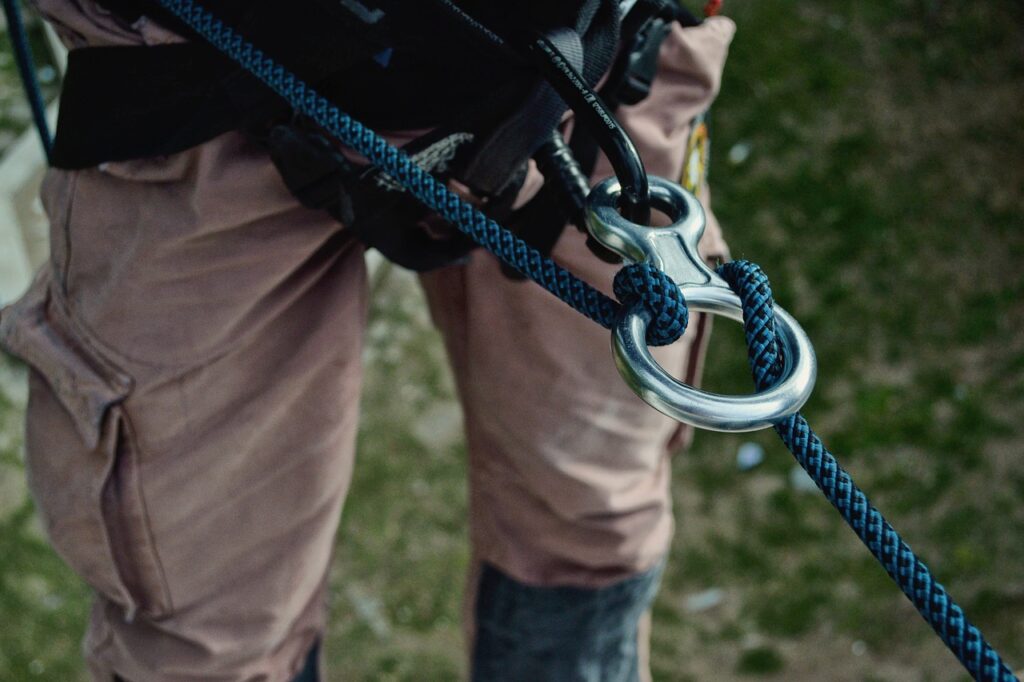
Safety is paramount in rock climbing, and understanding and following proper safety practices is essential for a successful and enjoyable climbing experience. This section provides a concise set of safety tips specifically tailored for beginner climbers. By familiarizing yourself with these tips, you can minimize risks, prevent injuries, and ensure a safe climbing environment.
In the Safety Tips section, you will find guidance on various aspects of climbing safety. From understanding gym or crag rules and etiquette to dressing appropriately for the climbing environment, these tips will help you navigate potential hazards and make informed decisions.
- Familiarize yourself with the climbing gym or crag rules and etiquette: Before you start climbing, make sure you understand and follow the specific rules and etiquette of the climbing gym or outdoor crag you’re visiting. Respect the guidelines provided to ensure a safe and harmonious climbing environment for everyone.
- Warm up properly before climbing to prevent injuries: Prioritize a thorough warm-up routine before each climbing session. Engage in dynamic stretches and exercises that target the muscles you’ll be using during your climbs. Warming up helps increase blood flow, and flexibility, and reduces the risk of injuries.
- Practice falling safely and learn how to spot your climbing partner: Falling is an inherent part of climbing. Learn and practice proper falling techniques, such as bending your knees, rolling with the fall, and avoiding reaching out to break your fall. Additionally, when climbing with a partner, learn how to spot them by providing a safe landing and guiding them away from potential hazards.
- Dress appropriately for the weather and the climbing environment: Wear suitable clothing that allows for freedom of movement and protection. Consider the weather conditions, such as temperature, wind, and precipitation, as well as the type of climbing you’ll be engaging in. Dress in layers to adjust to changing conditions, and don’t forget to wear comfortable and supportive climbing shoes.
- Bring a first aid kit and know basic first aid skills: Always carry a well-stocked first aid kit with you when climbing. Familiarize yourself with basic first aid procedures, such as treating minor cuts, scrapes, sprains, and strains. Knowing how to respond to common climbing-related injuries can make a significant difference in emergency situations.
- Respect the environment and leave no trace: As climbers, it’s our responsibility to protect and preserve the natural environment. Follow the principles of “Leave No Trace” by minimizing your impact on the climbing area. Avoid damaging vegetation, dispose of waste properly, and be mindful of local regulations and sensitive ecosystems.
- Don’t climb beyond your ability level: It’s crucial to know your limits and climb within your skill and fitness level. Progress gradually, focusing on building technique, strength, and experience. Pushing yourself too far beyond your capabilities can lead to accidents and injuries.
- Learn how to properly clean and maintain your gear: Regularly inspect and clean your climbing gear to ensure it remains in optimal condition. Follow manufacturer guidelines for maintenance and storage. This includes cleaning and drying ropes, inspecting carabiners and harnesses for wear, and checking the condition of your climbing shoes.
- Don’t climb alone: Climbing with a partner is highly recommended for safety reasons. Having a climbing partner provides an extra layer of support, including belaying, spotting, and assistance in case of emergencies. If you’re unable to find a partner, consider joining a climbing club or community to connect with fellow climbers.
- Learn how to properly pack and carry your gear: Properly organizing and packing your climbing gear is essential for efficiency and safety. Distribute the weight evenly, secure loose items, and ensure quick access to essential equipment during climbs. Familiarize yourself with proper techniques for carrying gear, such as using a backpack or attaching gear to your harness.
- Learn how to properly anchor yourself when climbing outdoors: When climbing outdoors, understanding how to anchor yourself securely is crucial for your safety. Learn various anchoring techniques, such as setting up top rope anchors or building multi-point anchors, and practice them under the guidance of experienced climbers or instructors.
- Learn how to properly rappel: Rappelling, or descending a rope, is a valuable skill for many climbing situations. Learn the proper techniques for setting up rappel systems, controlling your descent, and managing the rope. Practice rappelling in controlled environments and seek guidance from experienced climbers to ensure your safety.
- Always wear a helmet: Protect your head from falling rocks and other hazards by wearing a climbing helmet. Even in controlled environments, there’s always a risk of loose debris or accidental impacts. Invest in a properly fitting helmet designed for climbing and make it a habit to wear it at all times during climbs.
- Use a harness: A climbing harness is an essential piece of equipment that keeps you attached to the rope and provides support and protection. Learn how to properly put on a harness, adjust it for a secure fit, and double-check the buckles and connections before climbing.
- Tie a proper knot: Learn how to tie a figure-eight knot, one of the most common and reliable knots used in climbing. Double-check your knot before starting your climb to ensure it is correctly tied and secure. Regularly review and practice knot-tying skills to maintain proficiency.
- Use a belay device: A belay device is a critical tool for controlling the rope during climbing and protecting against falls. Familiarize yourself with different types of belay devices and their proper usage. Understand how to lock off the rope and release it smoothly to provide a controlled belay for your climbing partner.
- Communicate with your partner: Clear communication with your climbing partner is essential for a safe and successful climbing experience. Establish and use clear signals or verbal cues to indicate when to climb, stop, lower, or provide assistance. Regularly check in with your partner to ensure you both understand and are comfortable with the climbing plan.
- Check your gear: Before each climb, inspect your gear thoroughly. Check for signs of wear, such as frayed ropes, worn carabiners, or damaged harnesses. Replace any compromised gear immediately. Regularly maintain and replace climbing equipment to ensure its reliability and performance.
- Know your limits: Recognize and respect your physical and mental limits as a climber. Avoid pushing yourself beyond what you’re comfortable with, as it can increase the risk of accidents and injuries. Listen to your body, take breaks when needed, and communicate openly with your climbing partners about your abilities and limitations.
- Learn to fall: Falling is a normal part of climbing, and knowing how to fall safely is essential. Trust in your gear and focus on maintaining a controlled posture during a fall. Bend your knees, aim for soft landing positions, and avoid instinctively reaching out to break your fall, as it can lead to injuries.
4. Mental Tips
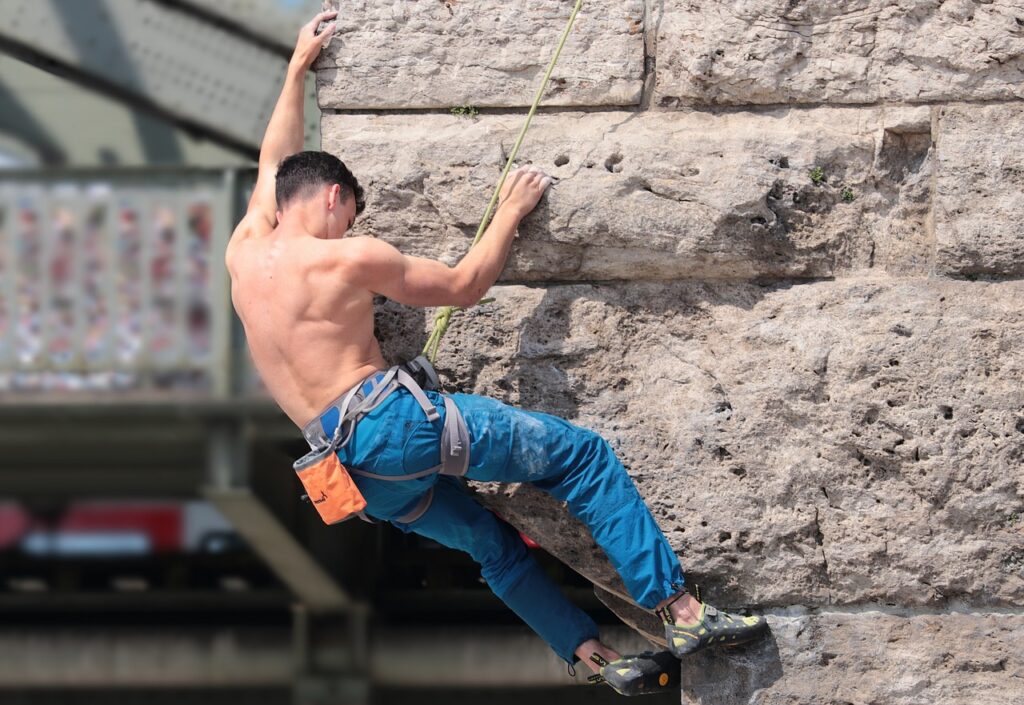
Rock climbing is not only a physical endeavor but also a mental challenge. Developing a strong and resilient mindset is crucial for success and enjoyment in climbing. In this section, we explore a set of mental tips specifically tailored for beginner climbers, aimed at helping you cultivate the mental skills needed to overcome obstacles, manage fear, and stay focused on the wall.
By incorporating these mental tips into your climbing practice, you can unlock your true potential and experience a deeper connection between mind and body. Building mental strength and resilience will not only improve your climbing performance but also enhance your overall enjoyment and satisfaction with the sport.
- Set realistic goals and track your progress to stay motivated: Set achievable goals for each climbing session, whether it’s completing a particular route or improving a specific technique. Break down larger goals into smaller milestones to track your progress. Celebrate your achievements along the way, and use them as motivation to keep pushing yourself.
- Visualize yourself successfully completing the climb before attempting it: Mental imagery is a powerful tool in climbing. Before starting a climb, take a moment to visualize yourself successfully reaching the top. Imagine each move, feel the holds, and experience the satisfaction of completing the climb. Visualization can help build confidence and prepare you mentally for the challenges ahead.
- Learn how to manage fear and anxiety while climbing: Fear and anxiety are common emotions in climbing, especially when facing difficult or exposed routes. Develop techniques to manage these emotions, such as deep breathing, positive self-talk, and focusing on the present moment. Understand that fear can be a useful tool for keeping you safe, but learn to differentiate between rational and irrational fears.
- Stay focused and present in the moment while climbing: Climbing requires concentration and mental focus. Avoid distractions and fully immerse yourself in the present moment. Pay attention to your body movements, the texture of the holds, and the dynamics of the climb. By staying present, you can react quickly to changes in the route and make precise movements.
- Celebrate your successes and learn from your failures: Acknowledge and celebrate your accomplishments, no matter how small they may seem. Each successful climb or improvement in technique is a milestone worth recognizing. Similarly, view failures as opportunities for growth and learning. Analyze what went wrong, identify areas for improvement, and approach each failure as a stepping stone toward success.
- Embrace failure: Failure is an inherent part of learning and progression in climbing. It’s normal to fall or be unable to complete a climb, especially as a beginner. Embrace failure as a natural part of the process and an opportunity to learn and improve. Don’t let setbacks discourage you; instead, use them as motivation to persevere and push your boundaries.
5. Training Tips
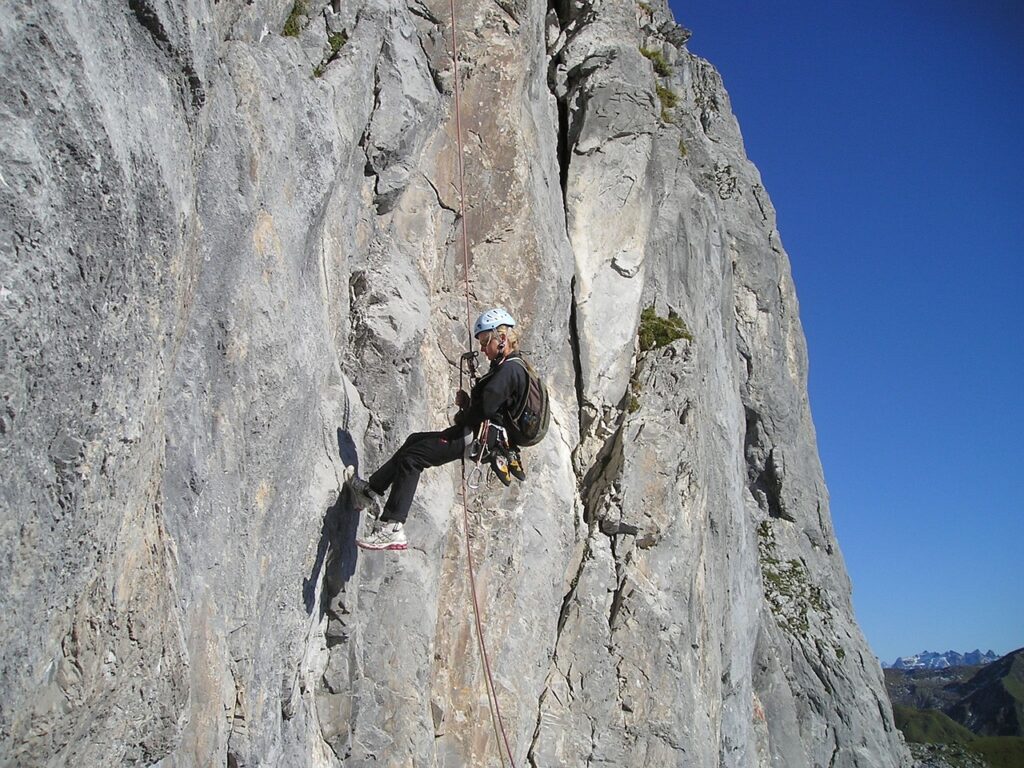
To excel in rock climbing, it’s important to develop the physical attributes and skills necessary to tackle challenging routes and improve your overall performance. This section focuses on providing training tips specifically designed for beginner climbers, offering guidance on how to enhance your strength, endurance, flexibility, and climbing technique.
Let’s explore the Training Tips section and discover effective strategies to build your physical capabilities and take your climbing to new heights!
- Incorporate strength training exercises into your workout routine: Building overall strength is crucial for climbing. Include exercises like pull-ups, push-ups, and core workouts to develop upper body and core strength. Strengthening these muscle groups will improve your ability to make controlled movements and maintain stability while climbing.
- Improve your grip strength: Grip strength plays a significant role in climbing. Perform finger-strengthening exercises, such as finger hangs on a hang board or using grip trainers. These exercises will help increase your finger and forearm strength, allowing you to hold onto smaller holds and maintain better control on the wall.
- Increase your endurance: Climbing requires both strength and endurance. Incorporate cardio exercises into your routine, such as running, cycling, or swimming, to improve your cardiovascular fitness and endurance. This will enable you to sustain your climbing efforts for longer periods and recover more quickly between climbs.
- Practice yoga or stretching: Flexibility and mobility are essential for efficient climbing and injury prevention. Engage in regular yoga sessions or stretching exercises to improve your flexibility, particularly in your hips, shoulders, and legs. This will enhance your range of motion, allowing for better body positioning and reducing the risk of strains or overuse injuries.
- Climb regularly: Consistency is key to improving your climbing skills. Aim to climb at least 2-3 times a week to build strength, technique, and familiarity with different types of routes and holds. Regular climbing sessions will help your body adapt and improve your overall climbing abilities.
- Mix it up: Vary your climbing routine to challenge yourself and prevent boredom. Explore different types of climbing, such as bouldering, sport climbing, or trad climbing. Additionally, try climbing on different types of rock or indoor walls with varying angles and features. This will expose you to different challenges and improve your adaptability as a climber.
- Cross-train: Incorporate other forms of exercise into your training regimen to enhance your overall fitness. Consider activities like weightlifting, yoga, or cardio exercises to target different muscle groups, improve overall strength and flexibility, and prevent muscular imbalances.
- Rest and recover: Allow your body adequate time to rest and recover between climbing sessions. Overtraining can lead to fatigue, decreased performance, and increased risk of injuries. Listen to your body’s signals and incorporate rest days into your training schedule. Use this time for active recovery, such as light stretching or mobility exercises, to aid in muscle repair and prevent overuse injuries.
- Get feedback: Seek feedback from experienced climbers or instructors to improve your climbing technique. They can provide valuable insights, identify areas for improvement, and suggest specific drills or exercises to address weaknesses. Participate in climbing classes, workshops, or find a mentor who can guide you on your climbing journey.
- Watch videos: Watch climbing videos to learn new techniques, study the movements of experienced climbers, and get inspired. Online platforms and climbing documentaries offer a wealth of knowledge and visual examples that can help you understand various climbing techniques, route reading, and movement strategies.
- Join a community: Connect with other climbers by joining a climbing club, community, or online forums. Engaging with fellow climbers provides opportunities to share experiences, exchange tips, and advice, and find climbing partners. Being part of a supportive community can enhance your motivation, offer learning opportunities, and create lasting friendships.
Related: 35 Best Rock Climbing Tips For Beginners – Improve Quickly
Related: 13 Best Ways to Improve Your Climbing – Simple and effective
6. Outdoor Climbing Tips
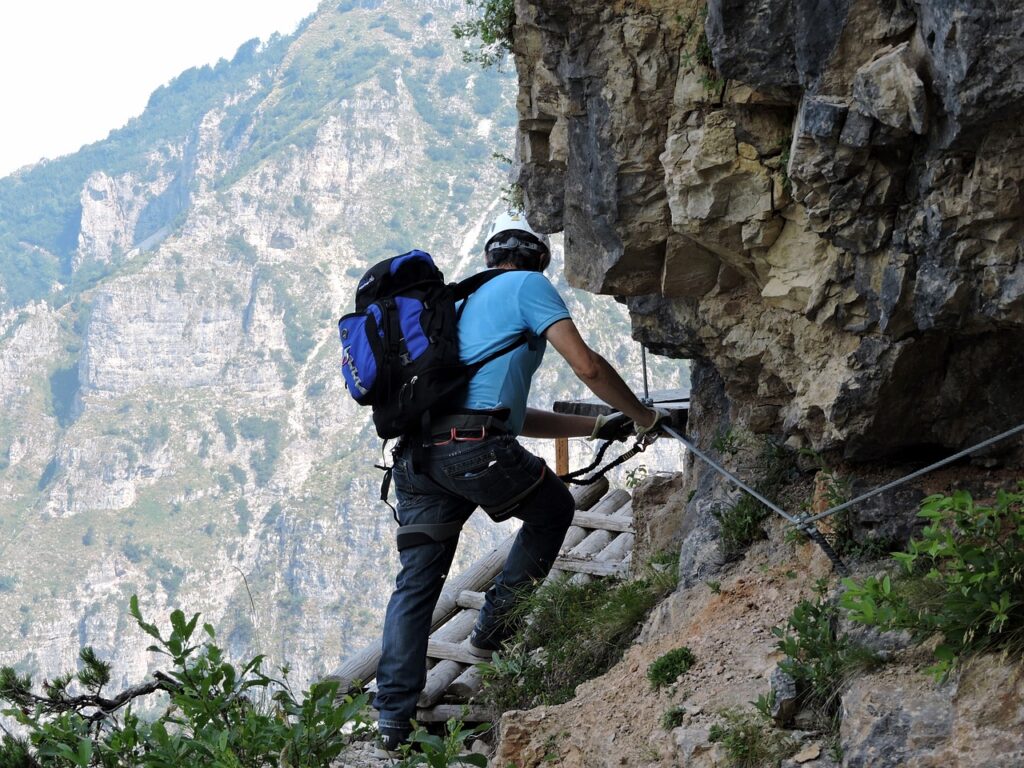
Taking your climbing skills to the great outdoors is an exciting and rewarding adventure. However, outdoor climbing presents unique challenges and considerations that differ from indoor climbing. In this section, we will explore a set of outdoor climbing tips specifically tailored for beginner climbers, offering guidance on how to navigate the natural environment and ensure a safe and enjoyable outdoor climbing experience.
Let’s delve into the Outdoor Climbing Tips section and gain the knowledge and skills necessary to embark on thrilling outdoor climbing adventures while staying safe and respectful of the natural environment!
- Learn how to properly use and place protection gear when climbing outdoors: Outdoor climbing often requires the use of protective gear such as cams, nuts, and slings. Take the time to learn how to properly place and use this gear to protect yourself in case of a fall. Seek guidance from experienced climbers or consider taking a course to learn the techniques and principles of traditional or sport climbing protection.
- Know the area: Before heading to an outdoor climbing destination, research the area and familiarize yourself with the routes, grades, and potential hazards. Obtain guidebooks or access online resources that provide detailed information about the climbing routes, access points, and any special considerations for the area. Understanding the nature of the routes and the rock formations will help you plan your climbs effectively.
- Check the weather: Stay informed about the weather conditions before heading out for an outdoor climbing session. Avoid climbing in bad weather, as it can make the rock slippery, increase the risk of accidents, or even lead to dangerous situations such as lightning strikes. High winds can also impact your stability and safety on the wall.
- Leave no trace: Practice responsible climbing by leaving the natural environment as you found it. Pack out all your trash, including food wrappers, tape, and other waste. Minimize your impact on the surroundings by avoiding unnecessary damage to vegetation or wildlife habitats. Follow the principles of Leave No Trace and be a steward of the outdoors.
- Be prepared: When climbing outdoors, be prepared for unforeseen circumstances. Bring plenty of water to stay hydrated, pack nutritious food for sustained energy, and carry extra gear such as headlamps, extra layers, and a first aid kit. Outdoor environments can be unpredictable, so it’s important to be prepared for emergencies or unexpected situations.
- Follow the rules: Respect any posted rules or regulations in the climbing area. Some areas may have specific guidelines for access, camping, or route closures to protect sensitive ecosystems or wildlife. Be considerate of other climbers and give them ample space. Avoid crowding routes and be patient when waiting for your turn.
- Communicate with your partner: Establish clear and effective communication with your climbing partner before starting a climb. Use standard climbing signals or establish your own signals that both of you understand. Discuss your climbing plans, such as belay systems, route choices, and any potential hazards. Clear communication is essential for a safe and enjoyable climbing experience.
- Be aware of your surroundings: Pay attention to your surroundings while climbing outdoors. Watch for loose rocks or other potential hazards that could pose a danger to you or other climbers. Be cautious of falling debris from climbers above. Maintain situational awareness to ensure your safety and the safety of those around you.
- Learn to rappel: Rappelling is a fundamental skill for outdoor climbing, especially when descending from a route. Learn how to rappel safely and effectively before attempting outdoor climbs. Understand proper anchor setups, rope management, and techniques for a controlled descent. Seek guidance from experienced climbers or take a course to gain proficiency in rappelling.
Related: Top 15 Best Rock Climbing Places for Kids: Indoor and Outdoor
7. Indoor Climbing Tips
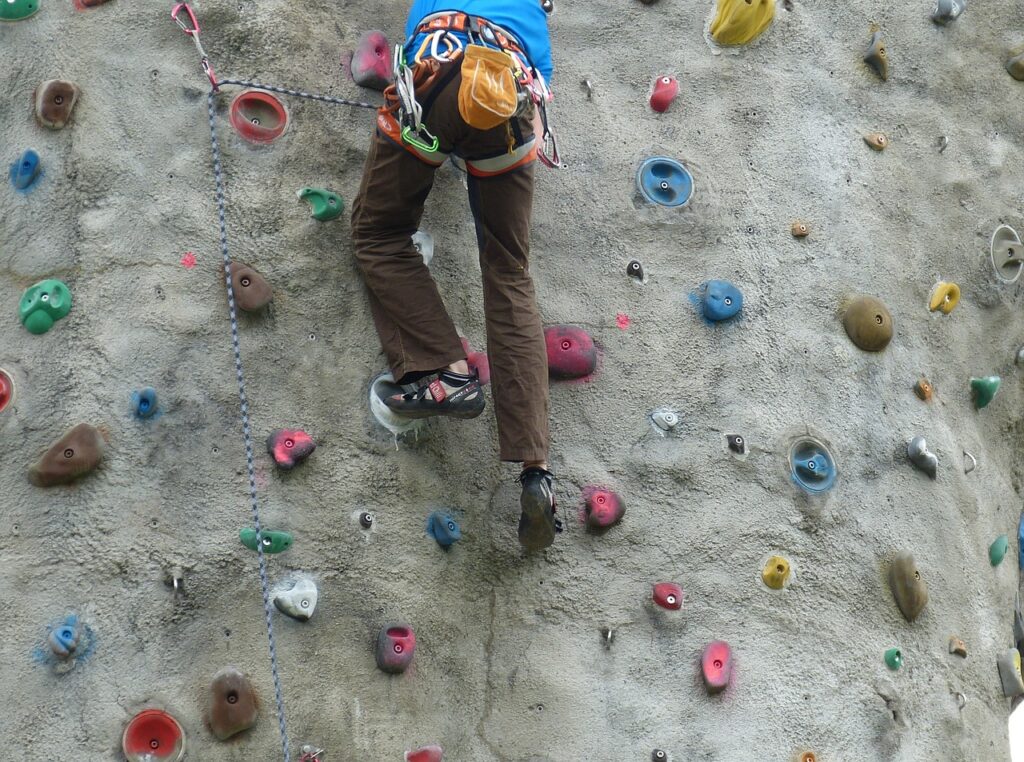
Indoor climbing provides an accessible and controlled environment for beginner climbers to learn and develop their skills. In this section, we will explore a set of indoor climbing tips specifically tailored for beginners, offering guidance on how to make the most of your indoor climbing experience and improve your climbing abilities.
Let’s explore the Indoor Climbing Tips section and discover how to make the most of your indoor climbing sessions, improve your technique, and build a solid foundation for your climbing journey!
- Find a gym: Look for a climbing gym in your area and consider joining. Climbing gyms provide a controlled and safe environment for beginners to learn and practice climbing. Take a beginner’s class or introductory session to familiarize yourself with the gym’s facilities, equipment, and safety protocols.
- Practice technique: Indoor climbing is an excellent opportunity to focus on improving your climbing technique. Pay attention to body positioning, footwork, and efficient movement on the wall. Take advantage of the indoor environment to refine your technique and develop good habits that will benefit you in both indoor and outdoor climbing.
- Try different routes: Challenge yourself by attempting routes of varying difficulty levels. Climbing gyms offer a wide range of routes with different holds, angles, and movements. Don’t be afraid to step out of your comfort zone and try routes that push your limits. This will help you improve your skills, build strength, and expand your climbing abilities.
- Use the training area: Many climbing gyms have a designated training area equipped with hang boards, campus boards, and other training tools. Make use of these resources to supplement your climbing workouts. Hang boards can help improve finger and forearm strength, while campus boards can develop upper body power and coordination. However, it’s essential to use these tools with proper technique and guidance to avoid injury.
- Have fun: Above all, remember that climbing is supposed to be enjoyable! Embrace the challenge, have fun, and don’t take yourself too seriously. Climbing is a journey that involves learning, growing, and experiencing new heights. Celebrate your progress, enjoy the process, and appreciate the unique community and culture that surrounds climbing.
Related: 10 Best Climbing Gyms in Denver – Climb With Your Kids
Related: Best Rock Climbing Gyms In San Diego
8. Other Tips
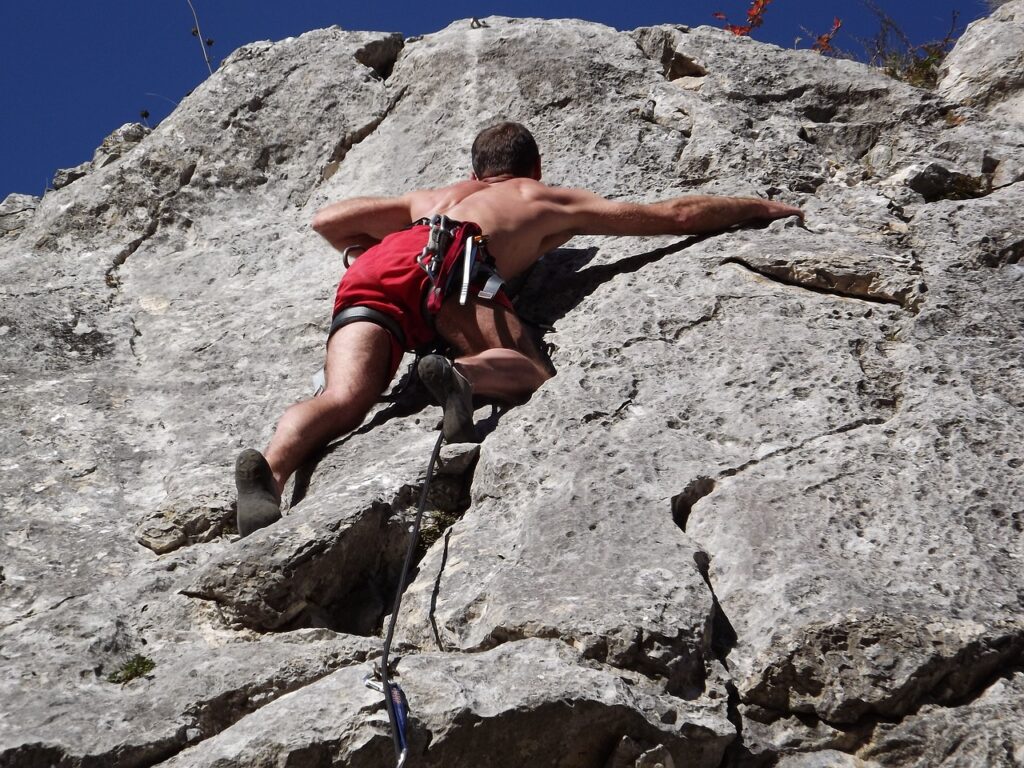
In addition to the fundamental aspects of climbing, there are various other tips and practices that can enhance your overall climbing experience and contribute to your growth as a climber. This section delves into a collection of miscellaneous tips and suggestions tailored for beginner climbers, covering a range of topics beyond the core technical and training aspects of climbing.
Let’s dive into the Other Tips section and discover these additional tips and practices that can enrich your climbing journey and help you develop into a well-rounded and knowledgeable climber!
- Get out and climb: The most effective way to improve your climbing skills is simply to get out and climb as much as possible. Experience on the wall is invaluable for building strength, honing technique, and gaining confidence. Take every opportunity to climb, whether it’s at a gym, on an indoor wall, or in outdoor settings.
- Be respectful of people’s experiences: Climbing is a community-driven sport, and it’s important to respect the experiences and knowledge of more seasoned climbers. Don’t hesitate to seek help, advice, or guidance from climbers who have more experience than you. They can offer valuable insights, share safety tips, and help you progress in your climbing journey.
- Draft a mission statement for your work: Creating a mission statement for your climbing practice can help you clarify your goals, motivations, and values. It serves as a guiding statement that reminds you of why you climb and what you hope to achieve. Reflect on your aspirations, whether it’s to conquer challenging routes, improve specific skills, or simply find joy in the process of climbing.
- Turn stories into workshops: Take moments from your climbing experiences and transform them into learning opportunities. Whether it’s a challenging climb, a memorable success, or a lesson learned from a mistake, these stories can be shared with others through workshops or informal discussions. By reflecting on these experiences and analyzing them, you can deepen your understanding and advance your climbing craft.
- Reading other works: Expand your knowledge and inspiration by reading books, articles, and guides related to climbing. Explore both content and form to understand the different perspectives and techniques used in climbing literature. By immersing yourself in the writings of other climbers, you can gain insights into what you aim to build in your own climbing journey and identify the tools and skills you need to develop.
Conclusion
Congratulations on taking the first step toward becoming a rock climber! This guide has provided a wealth of tips and advice to support beginner climbers on their journey. By focusing on climbing techniques, safety practices, mental preparation, training strategies, and outdoor considerations, you now have a solid foundation to build upon.
Remember, climbing is a combination of physical and mental challenges, and it requires practice, patience, and perseverance. Embrace the learning process, celebrate your successes, and learn from your failures. Climbing is not just about reaching the top; it’s about enjoying the journey and the sense of accomplishment that comes with pushing your limits.
As you continue your climbing adventure, always prioritize safety, respect the environment, and foster a sense of community. Seek guidance from experienced climbers, listen to their stories, and share your own experiences to inspire and learn from one another.
Whether you find yourself climbing indoors at a gym or venturing into the great outdoors, remember to have fun, be curious, and stay motivated. Rock climbing is an incredible sport that offers not only physical challenges but also a profound connection with nature and a chance to discover your own inner strength.
So, gear up, tie your knots, and embrace the vertical world. May your climbing journey be filled with thrilling ascents, breathtaking views, and lifelong memories. Stay safe, be inspired, and keep reaching new heights!









Discussion about this post